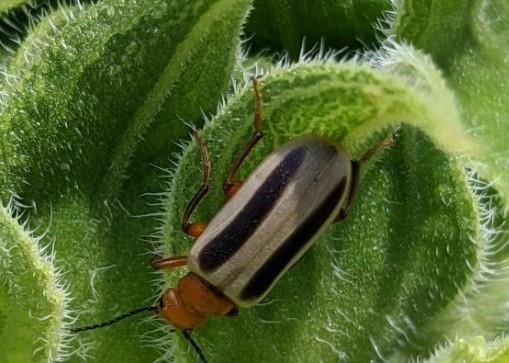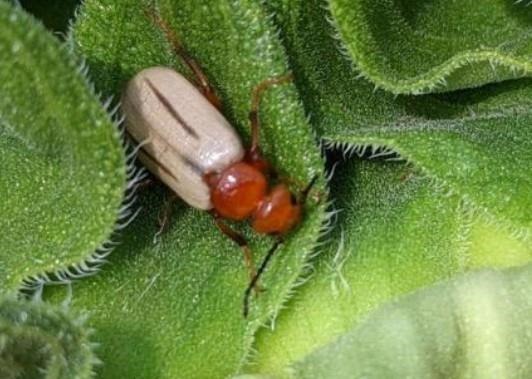By Adam Varenhorst
While scouting sunflower last week we noticed beetles that were present throughout the field on the developing buds. These beetles weren’t feeding on the buds or the bracts that they were often on. So, what were they doing on the sunflowers? We determined that these stationary beetles were a species of blister beetle, but unlike some of their relatives, they weren’t feeding on the green leaf tissue. We know that many blister beetles are attracted to flowering plants, but the field wasn’t flowering yet. We determined the beetles were Zonitis bilineata. This particular blister beetle doesn’t have a common name although a few researchers have described it as the two-lined blister beetle or two-lined Zonitis, which is derived from bilineata (bi = two and lineata = lined).
Description and Behavior

Figure 1. Zonitis bilineata adult with distinct black lines on abdomen. Photo courtesy of Philip Rozeboom.
Zonitis bilineata are ¼ to ½ of an inch in length. They have an orange head, thorax and legs. Their abdomen is covered by cream-colored hardened forewings that have a black line on each side (Figure 1). However, we’ve observed that these lines can vary among beetles with some being very large and obviously black to some being faded thin lines (Figure 2).

Figure 2. Zonitis bilineata adult with faint lines on abdomen. Photo courtesy of Philip Rozeboom.
The adults lay eggs on the underside of sunflower leaves. When the eggs hatch, the larvae will eventually move to the face of the flower. They will rest on the sunflower face until a bee approaches and then they will latch onto the bee using their mouthparts. The larvae use this strategy to then get carried to the bees’ egg chambers where they will be sealed in. The larvae of Zonitis bilineata first eat the egg that the bee laid in the cell, and then they will use the pollen and honey provisions for food.
Management
There are no management recommendations for these insects. Although we can’t find any information regarding the cantharidin concentration present in these beetles we recommend that you avoid handling them as they may still cause blistering.
Source : sdstate.edu